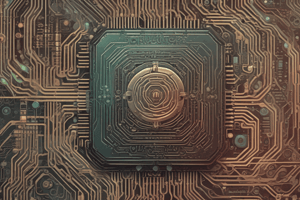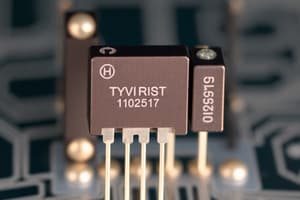Podcast
Questions and Answers
What is the maximum repetitive peak reverse voltage that a thyristor can withstand called?
What is the maximum repetitive peak reverse voltage that a thyristor can withstand called?
- Holding Current
- Voltage Rating (correct)
- Gate Trigger Current
- Surge Current
Which current is necessary to maintain the thyristor in the on-state after it has been triggered?
Which current is necessary to maintain the thyristor in the on-state after it has been triggered?
- Surge Current
- Gate Trigger Current
- Current Rating
- Holding Current (correct)
Which condition must be satisfied to turn off a thyristor using commutation?
Which condition must be satisfied to turn off a thyristor using commutation?
- Igt < Id
- IA < IH (correct)
- Vgt > Vdrm
- IA > IH
What do you call the process of applying reverse voltage to a thyristor to turn it off?
What do you call the process of applying reverse voltage to a thyristor to turn it off?
What is the method of turning off a thyristor where the source of commutation voltage is the supply itself called?
What is the method of turning off a thyristor where the source of commutation voltage is the supply itself called?
Which rating is defined as the minimum voltage required to turn the thyristor on?
Which rating is defined as the minimum voltage required to turn the thyristor on?
What must happen to the anode current during natural commutation for the thyristor to turn off?
What must happen to the anode current during natural commutation for the thyristor to turn off?
What is the minimum current required to turn the thyristor on referred to as?
What is the minimum current required to turn the thyristor on referred to as?
What condition occurs when the current in the circuit reaches natural zero?
What condition occurs when the current in the circuit reaches natural zero?
In which type of commutation does the supply source itself provide the commutation voltage?
In which type of commutation does the supply source itself provide the commutation voltage?
What is one effect of having a high dv/dt in a thyristor?
What is one effect of having a high dv/dt in a thyristor?
Why is the SCR turned off at the end of the positive half cycle?
Why is the SCR turned off at the end of the positive half cycle?
What does excessive di/dt during SCR operation lead to?
What does excessive di/dt during SCR operation lead to?
What is the main purpose of keeping the source impedance below the surge current rating of the SCR?
What is the main purpose of keeping the source impedance below the surge current rating of the SCR?
What is the primary reason for thyristor protection mechanisms?
What is the primary reason for thyristor protection mechanisms?
What unwanted situation can lead to SCR triggering?
What unwanted situation can lead to SCR triggering?
What type of cables are used for gate protection in SCRs to minimize unwanted triggering?
What type of cables are used for gate protection in SCRs to minimize unwanted triggering?
Which device is commonly used for monitoring temperature near a thyristor?
Which device is commonly used for monitoring temperature near a thyristor?
Which converters utilize natural commutation?
Which converters utilize natural commutation?
What occurs if an overvoltage condition exists in the gate circuit of a thyristor?
What occurs if an overvoltage condition exists in the gate circuit of a thyristor?
What is the primary function of a monitoring circuit in over-temperature protection?
What is the primary function of a monitoring circuit in over-temperature protection?
What is the role of the trip point in the temperature monitoring circuit for thyristors?
What is the role of the trip point in the temperature monitoring circuit for thyristors?
What can elevated temperatures do to thyristors if not properly managed?
What can elevated temperatures do to thyristors if not properly managed?
Which of the following does NOT directly contribute to effective gate protection for thyristors?
Which of the following does NOT directly contribute to effective gate protection for thyristors?
What happens to the charging time of the capacitor when the value of variable resistance RV is high?
What happens to the charging time of the capacitor when the value of variable resistance RV is high?
How does the use of a UJT in the firing circuit benefit the system?
How does the use of a UJT in the firing circuit benefit the system?
What role does diode D1 play in the RC half-wave firing circuit?
What role does diode D1 play in the RC half-wave firing circuit?
Which statement is true regarding the relationship between the firing angle and average output in the RC circuit?
Which statement is true regarding the relationship between the firing angle and average output in the RC circuit?
What factor is crucial in determining the capacitor charging time in the UJT firing circuit?
What factor is crucial in determining the capacitor charging time in the UJT firing circuit?
What is the consequence of firing the thyristor when the capacitor voltage reaches a specific positive value?
What is the consequence of firing the thyristor when the capacitor voltage reaches a specific positive value?
During which phase does the capacitor charge through diode D2 in the RC half-wave firing circuit?
During which phase does the capacitor charge through diode D2 in the RC half-wave firing circuit?
What effect does a lower value of RV have on the firing angle and average output?
What effect does a lower value of RV have on the firing angle and average output?
What action is taken when the monitored temperature exceeds the trip point?
What action is taken when the monitored temperature exceeds the trip point?
Which method is NOT mentioned for additional cooling mechanisms?
Which method is NOT mentioned for additional cooling mechanisms?
What is the purpose of predictive algorithms in thermal modeling?
What is the purpose of predictive algorithms in thermal modeling?
What type of control system is implemented with active cooling?
What type of control system is implemented with active cooling?
Which of the following is NOT a purpose of warning alarms in a thyristor protection system?
Which of the following is NOT a purpose of warning alarms in a thyristor protection system?
What happens during a protective shutdown of the system?
What happens during a protective shutdown of the system?
What factor does the choice of protection measures depend on?
What factor does the choice of protection measures depend on?
What is the primary function of the firing circuit of thyristors?
What is the primary function of the firing circuit of thyristors?
Flashcards are hidden until you start studying
Study Notes
Thyristor Ratings
- Voltage Rating (Vdrm or Vrrm): Maximum repetitive peak reverse voltage a thyristor can withstand.
- Current Rating (Idrm or Irrm): Maximum repetitive peak reverse current supported by the thyristor.
- Gate Trigger Voltage (Vgt): Minimum voltage required to turn the thyristor on.
- Gate Trigger Current (Igt): Minimum current required to activate the thyristor.
- Holding Current (Ih): Minimum current necessary to maintain the thyristor's on-state after triggering.
- Surge Current (Itsm): Maximum allowable surge current for short durations.
- Adhering to these ratings ensures thyristor reliability in various applications.
Thyristor Turn OFF/Commutation Process
- Commutation refers to the process of turning off a thyristor (SCR).
- Two primary conditions for turning off an SCR:
- Anode current (IA) must be less than holding current (IH).
- Sufficient reverse voltage must be applied to recover the blocking state.
- Natural Commutation: Utilizes the AC supply; the anode current naturally becomes zero at the end of each positive half-cycle, applying reverse voltage during the negative half-cycle.
- Forced Commutation: Accomplished through external circuit elements to turn off SCRs, used in various converter applications.
Thyristor Protection Mechanisms
- Di/dt Limitations: Large di/dt during SCR activation can lead to damage.
- dv/dt Sensitivity: High dv/dt may result in unintended triggering.
- Circuit Protection: Utilizes fuses and circuit breakers for overcurrent control, ensuring safe operational limits.
Gate Protection
- Protecting the gate from overvoltage and overcurrent is essential to avoid false triggering and damage due to temperature rise.
- Shielded Cables: Employed to minimize induced electromagnetic force, thereby reducing unwanted gate triggering.
Over-Temperature Protection
- Temperature Sensing Devices: Thermistors or sensors monitor the temperature near the thyristor.
- Monitoring Circuit: Compares sensor output to defined thresholds to initiate protective actions.
- Threshold Settings: A trip point defines when protective measures are activated, based on safe operating temperatures.
- Cooling Systems: Incorporates fans, heat sinks, or liquid cooling to dissipate heat.
- Feedback Control: Closed-loop systems adjust cooling mechanisms in real-time based on temperature readings.
- Warning Alarms: Visual or audible signals alert when temperature approaches critical levels.
- Shutdown and Restart Protocols: Activates protective shutdown if temperatures are exceeded, allowing for safe system resets post-cooling.
Firing Circuit of Thyristors
- Critical for controlling thyristor triggering and conduction state.
- RC Half-Wave Firing Circuit: Capacitor charges during negative half-cycles and triggers the thyristor when reaching a positive voltage threshold; firing angle is dependent on resistor values.
- UJT Firing Circuit: Reduces power dissipation in the gate by generating sharp, repeated pulses through UJT oscillation; pulse generation is influenced by the variable resistance.
General Notes
- Understanding these parameters and protection mechanisms is vital for implementing dependable thyristor-based power control systems in various applications.
Studying That Suits You
Use AI to generate personalized quizzes and flashcards to suit your learning preferences.




